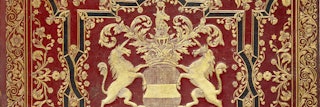Luxurious book bindings were the specialty of Suenonius Mandelgreen, a famous Zeeuwse bookbinder from the 18th century. In 1755 he crafted a special binding for the speech of a bright 14-year old boy.
Suenonius Mandelgreen was born in Uppsala, Sweden, and worked in Middelburg from 1736 until his death in 1758. In Sweden he was taught the craft of bookbinding, including the stamping of book bindings in gold. The binding as pictured below was made in Middelburg.

The binding, made of red Levant, is stamped with gold in a ribbon pattern which is partly filled with black, flowers and plants. The Van Borssele coat-of-arms is located in the center. In the corners, cupids fire arrows at a flying heart with the words ‘in the hope’. For bracteate, Mandelgreen used purple paste paper with a blind embossing of a woodblock.

Bright 14-year old boy
The binding contains an oration concerning the history and merits of the Zeeuwse family Van Borssele. The text was recited in Latin by a smart boy of 14 years old, Jona Willem te Water, as an expression of gratitude for his patron Jan van Borssele. The speech was dedicated to Jan van Borssele’s wife, Anna Margaretha Elisabeth Coninck.
Jan van Borssele
Jan van Borssele (1707-1784) was an influential man. He represented the Stadtholder, Willem IV van Oranje, as First Noble of Zeeland. This function provided him with suffrage in the name of the class of the Chivalry in the States of Zeeland, the Admiralty of Zeeland and the College of Walcheren. Furthermore, he had the right to perform countless appointments.
Successful student
Due to Van Borssele’s financial support, the 14-year old Jona was able to study in Utrecht. And with success, for Jona Willem te Water would become professor of Theology and Religious History in Leiden.
Supposedly, Jona’s father – the Axelse vicar Willem te Water- was the one who compiled the oration. It was him who made the Dutch translation and added the annotations. The text is accessible via Google Books.
Luxurious binding
The bookblock was printed by Pieter Gillisen in Middelburg in 1755. Jan van Borrsele probably instructed Mandelgreen to provide a certain number of copies with a special lavish binding. In the archive of the family Van Borssele in the Zeeuws Archief one can find several bookblocks, of which two have a luxurious binding, including the one pictured below.
Bookbinder, publisher and auctioneer
Mandelgreen was bookbinder in addition to being printer/publisher and auctioneer. He and his family lived on the Market in Middelburg. In collaboration with printers A.L. Callenfels and L. Taillefert Mandelgreen started the publication of the Middelburgse Courant in 1758. The first newspaper was published on the 26th of April of the same year. Four-and-a-half months later, Suenonius Mandelgreen, his son Suenonius Christiaen and his wife Anna Catharina Smitsbergen passed away (Suenonius himself on the 10th of September, his son on the 20th of September and his wife on the 22th of September).
Suenonius Mandelgreen (?-1758), bookbinding, 1755, red Levant stamped in gold, dimensions: 27,1×21,2 cm, 35 pages.
Speech in the honor of, and about the merits of the illustrious family Van Borssele, orated by Jona Willem te Water in Flushing, translated from Latin and enriched with annotations by Willem te Water (Middelburg: Pieter Gillisen 1755). Archive family Van Borssele van der Hooge, inv. nr 145 en 145a.
Literature
- Storm van Leeuwen, J., Een unieke boekband door Sueno[n]ius Mandelgreen, in: Nehalennia 55 (1984)
- Storm van Leeuwen, J., De achttiende eeuw: hoogtij van fraai Middelburgs bindwerk, in: Goud en velijn. Middelburgse boekbanden van de 17de tot de 19de eeuw (Middelburg 1992)
